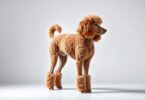Nearly 10-20% of people worldwide react to pet allergens, yet many assume fur alone causes sneezing and itching. The truth? Proteins in pet dander, saliva, and urine trigger most reactions. This means even “hypoallergenic” breeds aren’t completely allergy-proof.
Yorkshire Terriers often top lists of low-allergen companions. Their fine, silky hair sheds minimally compared to double-coated dogs, reducing airborne irritants. According to the American Kennel Club, this trait makes them a practical choice for mild allergy sufferers.
However, individual responses vary widely. Some owners report no issues, while others still experience symptoms. Testing exposure through brief interactions helps gauge personal tolerance before adoption.
Proactive measures like frequent grooming and air purification can further minimize risks. Always consult an allergist if considering bringing home any four-legged friend—especially when sensitivities exist.
Understanding Dog Allergies and What Triggers Them
Contrary to popular belief, it’s not dog hair but tiny proteins in their skin flakes that trigger most allergic reactions. These microscopic particles, called Can f 1 and Can f 2, stick to fur and become airborne. The Asthma and Allergy Foundation of America confirms this process creates lasting allergens in homes.
Identifying Common Allergen Sources in Pets
Three main sources spread allergy-causing proteins. Saliva transfers during grooming, urine leaves residues on surfaces, and dander sheds from skin. Breeds with fine coats, such as Yorkshire Terriers, may trap fewer particles but still carry these irritants. Regular brushing helps control buildup but doesn’t eliminate risks.
How Dog Dander Affects Allergy Sufferers
When dander becomes airborne, it enters nasal passages and lungs. Sensitive individuals experience reactions like watery eyes or congestion within minutes. Low-shedding dogs reduce floating particles but still produce allergens through natural skin renewal. Testing exposure through short visits helps assess personal tolerance levels.
Yorkie Coat Characteristics and Grooming Needs
Yorkshire Terriers boast one of the most distinctive coats in the canine world. Unlike typical fur, their strands grow continuously like human hair, creating flowing locks that demand special care. This unique feature makes coat maintenance both an art and a science for pet parents.
Unique Features of a Yorkie’s Coat
The silky texture of a Yorkie’s hair lacks the dense undercoat common in many breeds. Single-layer coats mean minimal seasonal shedding. While this reduces airborne irritants, the fine strands tangle easily without proper upkeep.
Effective Grooming Techniques for Low-Shedding Breeds
Daily brushing prevents mats and distributes natural oils. Use a stainless steel comb for detangling and a slicker brush for smoothing. Professional trims every 6-8 weeks maintain manageable length and reduce allergen-trapping debris.
Bathing every 3-4 weeks with hypoallergenic shampoo keeps skin healthy. Always dry the coat thoroughly to prevent mildew growth. These steps control dander while preserving the coat’s signature shine.
Pet owners should wipe paws after walks and clean bedding weekly. Combining home care with expert grooming creates optimal conditions for both dog and allergy-prone households.
Are Yorkies Hypoallergenic? Debunking the Myth
Many families mistakenly believe Yorkshire Terriers eliminate allergy risks. Science reveals even low-shedding breeds produce proteins that trigger reactions. The American Kennel Club clarifies no dog is truly hypoallergenic, though some breeds release fewer irritants.
The Role of Dander and Allergens in Yorkie Coats
This breed’s fine, hair-like coat traps less dead skin than thick-furred dogs. However, Yorkies still shed microscopic dander during normal activities. Proteins in saliva and urine also cling to surfaces, creating potential triggers.
Studies show individual sensitivity determines reaction severity. Some owners report mild sniffles, while others experience stronger responses. Spending time with the breed before adoption helps identify personal tolerance levels.
Regular baths and weekly brushing reduce allergen buildup. Air purifiers with HEPA filters capture floating particles. These steps minimize exposure but can’t eliminate biological processes inherent to all dogs.
Understanding this balance helps pet parents make informed choices. While Yorkshire Terriers rank among better options for allergy sufferers, proactive management remains essential for harmonious living.
Managing Allergies When Living with a Yorkie
Living comfortably with a dog requires smart strategies for allergy management. Preparation and environmental adjustments create safer spaces for sensitive individuals. Start by assessing personal tolerance levels before making long-term commitments.
Testing Your Reaction Before Adoption
Spend multiple hours interacting with the dog in different settings. Visit breeders or foster homes to observe symptoms over several days. Allergists recommend repeated exposure sessions to gauge bodily responses accurately.
Carry antihistamines during trial periods as a precaution. Track reactions like sneezing or skin irritation in a journal. This data helps determine if bringing home a new companion aligns with your health needs.
Home Modifications to Reduce Allergen Exposure
Install HEPA air purifiers in high-traffic areas to capture floating particles. Wash pet bedding weekly in hot water and vacuum carpets using sealed-system devices. Designate furniture-free zones to limit allergen spread.
Create a dog-free bedroom sanctuary for uninterrupted sleep. Use washable slipcovers on sofas and replace curtains with blinds. These steps make maintaining a clean house easier while managing allergies effectively.
Consult doctors about immunotherapy options if reactions persist. Combining medical support with proactive home care builds a sustainable environment for both pets and owners.
Yorkie Health and Wellbeing Essentials for Pet Parents
Proper care transforms tiny Yorkies into thriving companions. Their small size demands specialized attention to diet and medical needs. Pet parents must balance nutritional precision with proactive health monitoring.
Nutrition and Feeding Strategies
High-quality kibble formulated for toy breeds supports energy needs. Puppies require 4-5 small meals daily to prevent hypoglycemia. Adult dogs thrive on two measured portions to avoid obesity.
Omega-3 supplements improve skin condition and coat shine. Dental chews reduce plaque buildup between brushings. Always provide fresh water in shallow bowls suited to their petite stature.
Vigilance Against Breed-Specific Conditions
Collapsing trachea often manifests through honking coughs. Luxating patellas cause limping in active dogs. Regular vet screenings catch these issues early.
Brush teeth three times weekly using canine toothpaste. Monitor breathing during exercise in hot weather. Document weight changes – adults should stay under 7 pounds.
Establishing consistent care routines helps Yorkshire Terriers live 13-16 years. Partner with veterinarians who understand toy breed physiology for optimal results.
Caring for Your Yorkie: Training and Behavioral Insights
Training a spirited small breed requires patience and tailored strategies to harness their bold personality. These compact companions often display confidence exceeding their size, making early guidance essential for harmonious living.
Socializing and Behavioral Training Tips
Expose puppies to diverse environments between 8-16 weeks when socialization windows peak. Reward calm behavior around strangers with treats to build positive associations. Short, frequent sessions work better than marathon drills for attention spans.
Use clicker training to mark desired actions like sitting before meals. Redirect barking with quiet commands followed by praise. Consistency proves vital—all family members should enforce the same rules to prevent confusion.
Exercise and Mental Stimulation Techniques
Indoor agility courses using tunnels and low jumps channel energy constructively. Food puzzles like snuffle mats engage natural foraging instincts during meal times. Rotate toys weekly to maintain novelty and prevent boredom.
Teacup varieties require extra care during play due to delicate bone structure. Always use harnesses instead of collars during walks. Schedule three 15-minute activity blocks daily to balance physical and mental needs without overtiring little dogs.
Pair training with affection to strengthen bonds. This approach transforms feisty tendencies into endearing quirks, creating well-adjusted companions for active households.
Final Thoughts for a Happy Yorkie Home
Creating a harmonious home with a Yorkshire Terrier involves balancing practical care with realistic expectations. While their silky coat sheds minimally, no dog breed eliminates allergy risks completely. Regular grooming and smart home habits help manage skin particles and saliva proteins that trigger reactions.
Prioritize these essentials for thriving companions:
• Weekly brushing and professional trims maintain coat health
• High-quality nutrition supports skin condition and energy levels
• Consistent training builds trust with bold personalities
Families should test interactions with the breed before committing. Those with sensitivities might benefit from air purifiers and designated pet-free zones. Always consult veterinarians about dietary needs or allergy management plans.
Remember: dogs bred for companionship thrive when owners understand their unique requirements. By combining informed choices with dedicated care, you create lasting bonds with these spirited little dogs. For personalized guidance, reach out to trusted breeders and animal health professionals.
FAQ
Do Yorkshire Terriers produce less dander than other breeds?
While no dog is completely hypoallergenic, Yorkies have hair-like coats that shed minimally, reducing dander spread. Regular grooming further minimizes allergens, making them a better choice for mild allergy sufferers.
How often should a Yorkie be groomed to manage allergens?
Weekly brushing and monthly baths with hypoallergenic shampoo help keep their coat clean and reduce dander. Professional trims every 6–8 weeks prevent matting, which traps allergens.
Can teacup Yorkies trigger fewer allergy symptoms?
Teacup Yorkies have the same coat type as standard-sized ones, so they don’t inherently produce fewer allergens. Their smaller size may limit allergen spread in smaller spaces, but individual reactions vary.










Leave a Comment